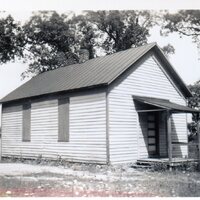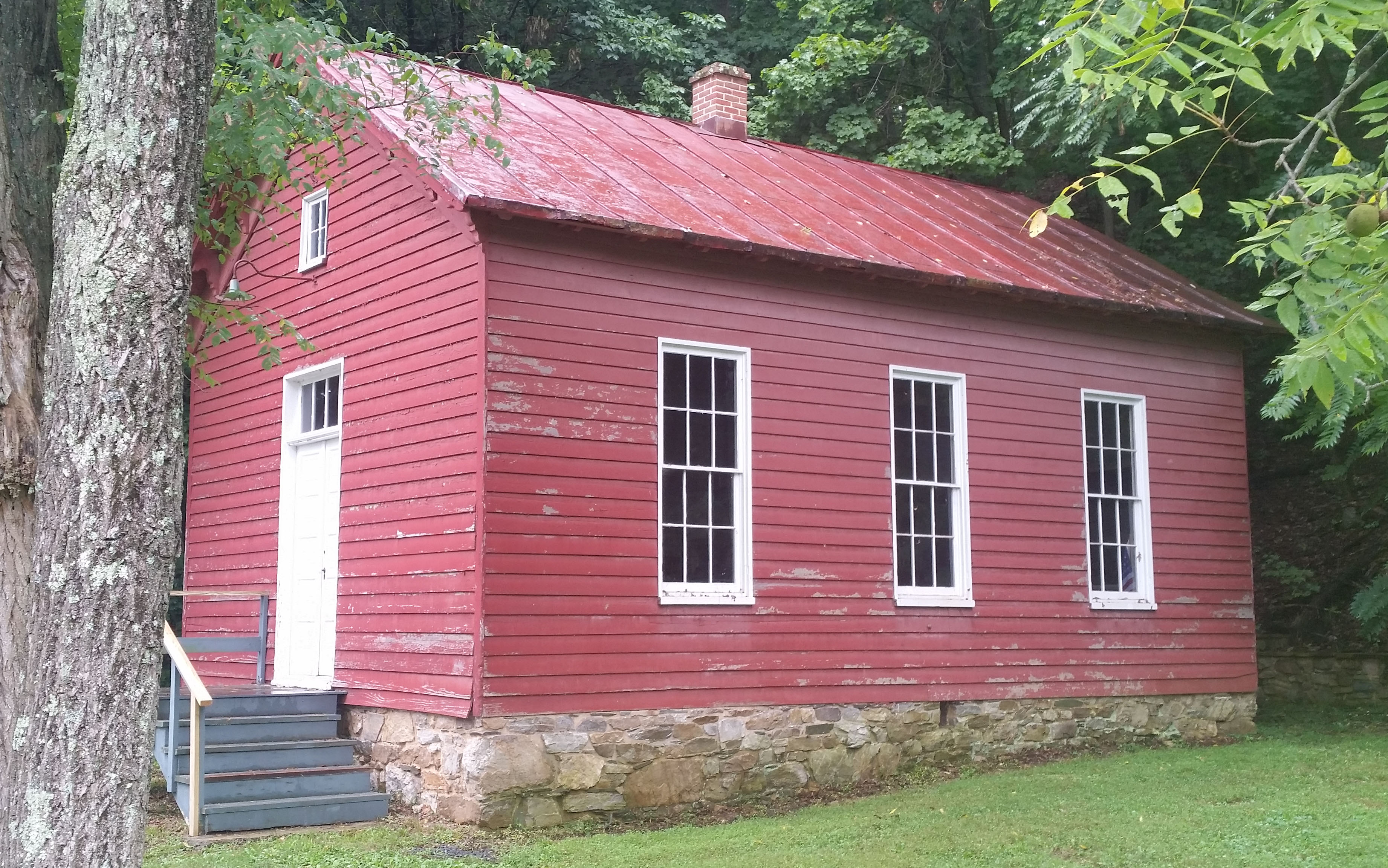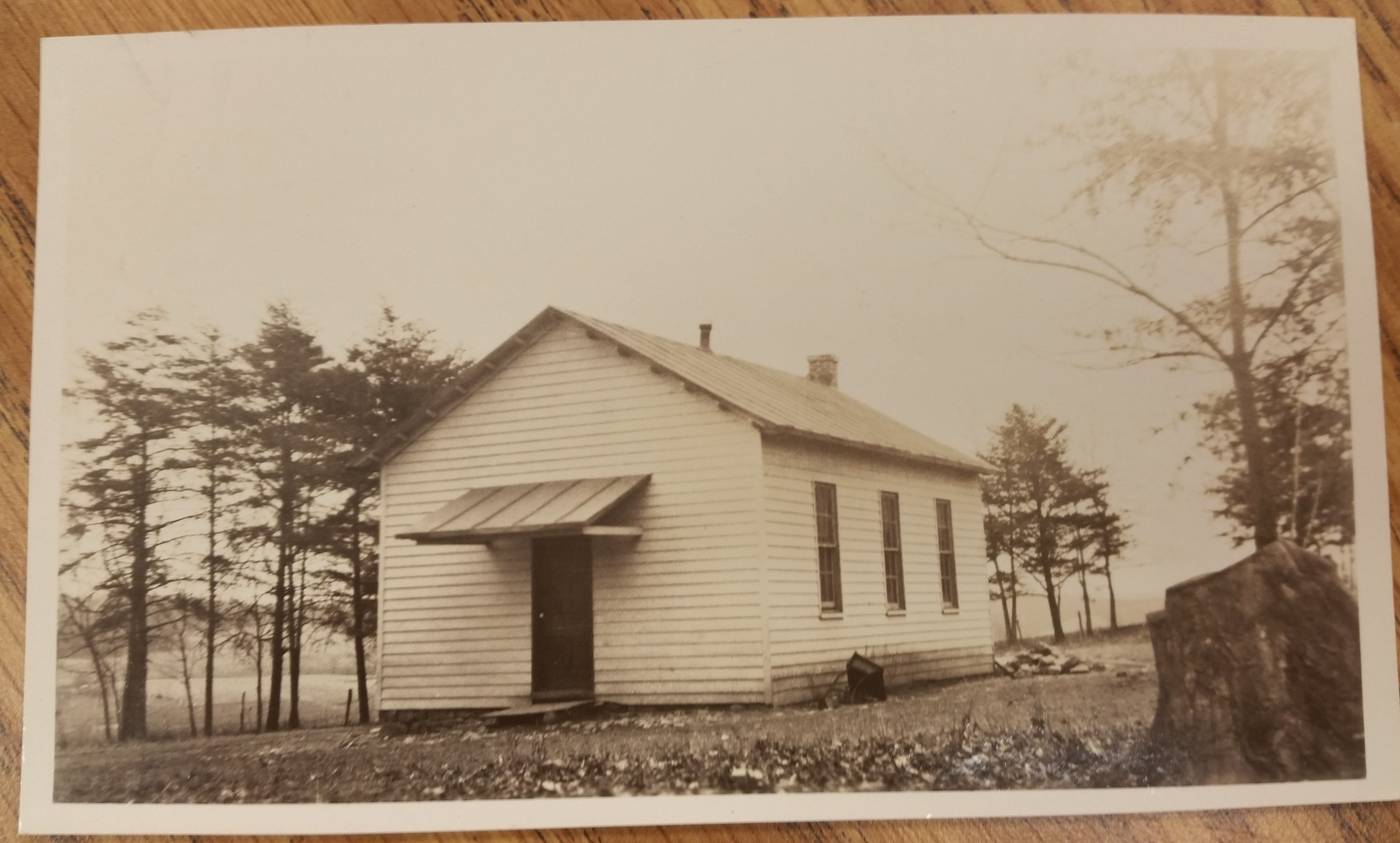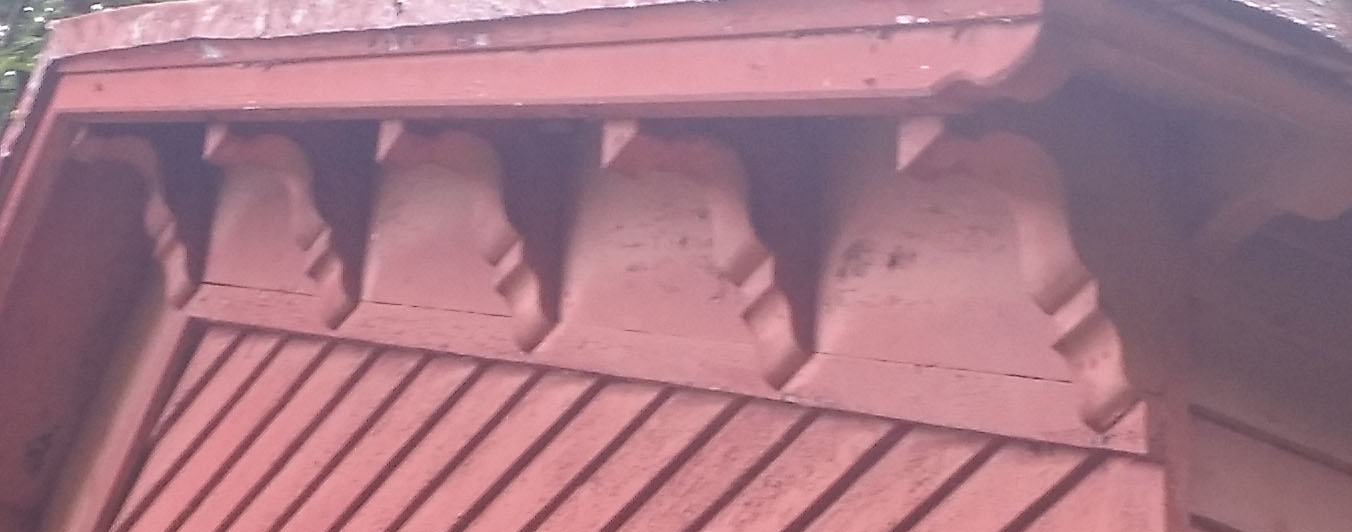Mountain Gap Colored and White

Photo By Thos E. Sims, Jr. Source: Insurance Analysis and Permanent Record – Property of Loudoun County School Board: Garrett Insurance Company (Fireman’s Fund Insurance Company), Leesburg, Virginia. October, 1940. Source: (Blue Insurance Binder, Box 11 EWS Archives.)
Opening and Closing
Colored School: 1887-1955
White School: 1887 - 1959.
There were two Mountain Gap schools, one for white children and one for Blacks, (then known as “colored). In 1938/39, the number designation for Mountain Gap Colored was #39. Source EWP 1.7 1939 Socio Econ Study. See also vertical file, Edwin Washington Archives in the Douglass HS building in Leesburg, which contains copies of records and newspaper articles.
- The building on Route 15 (the school for white children) is now owned by Oatlands Plantation; but was purchased in 1953 by Wilbur Hall, an important alumnus of the school who wanted to turn it into a memorial to a by-gone way of learning, the one-room school house. To accomplish this, over the summer of 1953, Route 15 was adjusted so that the school was left well set-back on an old spur. In addition, Mrs. Edith Mortin Euctace donated adjoining land to make an attractive picnic area. Euctace was the wife of the owner of Oatlands and was also the daughter of Levi P. Morton, Vice President under Benjamin Harrison and later governor or NY. Hall later donated the school to the School Board with an endowment and had in mind that the building could be used for community events. He also wanted water to be provided and picnic tables. Source: “Mountain Gap School, a Memorial,” Loudoun Times Mirror, page 1, November 19, 1953.
- Paper Term Reports are in Edwin Washington Archives. Mountain Gap Elementary White, Leesburg District 1924/25-1950/51 in 6.3.2 EWP Box 4.
Physical and Map Location
Petitions
Transportation
Walking was a common method of school transportation even before the creation of Loudoun County Public Schools (LCPS). It’s believed that students who lived within 3 miles of a school could walk from their home to school. The figure at https://edwinwashingtonproject.org/s/ewp/item/31329 shows the location of the school with a circle representing the area from which students could have walked, back and forth from their home to the school. Travel by horse was also used and could have extended the travel distance.
History
Mountain Gap Colored School:
- In 1889 the school board purchased land for the Mountain Gap Colored School and built the schoolhouse the following year. The building would then remain standing until the 1980’s, when it burned down; however, we are not certain yet of its life between the end of schooling and when the structure burned. The exact location appears to have been in Little Washington, a “colored community” and just down the road from the “kingdom,” an area of wealthy white owners along Evergreen Mills Road. Source: African-American Communities of Loudoun County, 2002.
- Blacks were anxious for education, following the Civil War. At the urging of John Gleed, a local leader in the Oatlands/Gleedsville area, the Leesburg school district purchased land on Mountain Gap Road from George Bryant on which was constructed the Mountain Gap Colored School, a one-room building framed with clapboard, with two windows on each side and painted white. Source: Nomination for National Register of Historic Places for Mt. Olive Methodist Episcopal Church, (DHR File 053-0994) and Eugene Scheel, Loudoun Discovered Vol 2. Leesburg and the Old Carolina Road, (Westminster: Willow Bend Books, 2002) 87. Its dimensions were 21′ x 31′ feet and by 1940, possessed a metal roof. Source: (Blue Insurance Binder, Box 11 EWS Archives.)
- Grace Murray and Elizabeth Johnson taught for the first few years at the colored school, then Bushrod “Bush” W. Murray assumed the role until he retired. Source: Staff at Journey Through Hallowed Ground Partnership. (2014). Gleedsville. Retrieved 11 21, 2014, from The Journey Through Hallowed Ground: http://www.hallowedground.org/African-American-Heritage/Gleedsville There was a Mountain Gap white school and a Mountain Gap black school, both were open in 1924-25. Source: Interview with Donna Kroiz, Records Office, LCPS, 11/10/2014. Regarding the Mountain School, there was an effort to sell in 1926; but the School Board resolved to ask the Circuit Court of Loudoun not to confirm the sale for 50 dollars.
- The “colored” school was Located in Gleedsville: Source: Staff at Journey Through Hallowed Ground Partnership. (2014). Gleedsville. Retrieved 11 21, 2014, from The Journey Through Hallowed Ground. It was constructed in 1887 as a one-room frame structure for $400. Source: Report of Survey Committee on Long Range Planning for Loudoun County, Jan 1940. Location: EWP Archives folder 2.2 County School Board, 1918-1952.
- In 1889 the school board established Mountain Gap (Colored) School, which looked much like the red-painted school for white children of the same name (left) built on Route 15, and the county’s last white operating one-room school when it closed in 1953, according to some records. Other notes indicate that at a meeting of the School Board on Feb 28, 1940, it was resolved to close the school Source: EWP 8.1 Loudoun County School Budget for Fiscal Year starting July 1, 1940, Pg 29.
- The “colored” school also ended operations in 1955 and like the white school was included in Leesburg District. We do not have full details on the sale of the “colored” school’s end of service, though we know that the structure may have burned down in the 1980’s. An unconfirmed legend has it that the charred remains were buried at the fence line between the current residential property and Oat Lands Plantation.
Mountain Gap White School:
- Lori Kimball at Oatlands researched this and noted that “in 1878 George Carter II and his wife sold 75 acres to James and Sarah Adams. In 1885 they sold one acre with a schoolhouse on it to the Loudoun public school system. We don’t know when the building was constructed or why the Adamses built one.”
- The white school was sold at public auction Saturday, April 4, 1959 on the steps of the Loudoun County Court House, Leesburg. Interestingly, the close might have been precipitated by the parents and patrons of the school, rather than the Superintendent, as is evidenced by an undated petition in the archives citing sanitation, inadequate water supply and poor academic opportunities as reasons for the children to be allowed to study in Leesburg. Staggered closing times for different grades also created commuting problem for parents Petition to Close Mountain Gap. Source: White Petitions, EWP Archives.
 Source: The original deed is in Deed Book 6Z, Folio 358 in the Archives of the Circuit Court of Loudoun County.. Described as a one room, frame school house. See also: Poster for Auction, School Box #2 in the archives. The folder contains a note indicating that Wilbur C. Hall purchased the Mount Gap white school on Route 15, 5 miles S of Leesburg for $2500 in a spirited auction. Hall was a long-time legal fixture in Loudoun. According to Loudoun historian Lori Kimbell, “He had attended school there and wanted to preserve the building and use it to education the public about one room schoolhouses, though it isn’t certain he ever got around to doing that. Hall died in 1972 and his will stipulated that all of his real estate holdings should be sold. The National Trust bought it in the early 1970’s and then then in the 1990s, Oatlands started to offer school programs based on teaching methods in the late 1800s. (FYI: Re-examining records to make sure they are all linked to the right buildings.) Hall was also one of Loudoun’s most colorful and influential legal and political figures, often considered for Governor.
Source: The original deed is in Deed Book 6Z, Folio 358 in the Archives of the Circuit Court of Loudoun County.. Described as a one room, frame school house. See also: Poster for Auction, School Box #2 in the archives. The folder contains a note indicating that Wilbur C. Hall purchased the Mount Gap white school on Route 15, 5 miles S of Leesburg for $2500 in a spirited auction. Hall was a long-time legal fixture in Loudoun. According to Loudoun historian Lori Kimbell, “He had attended school there and wanted to preserve the building and use it to education the public about one room schoolhouses, though it isn’t certain he ever got around to doing that. Hall died in 1972 and his will stipulated that all of his real estate holdings should be sold. The National Trust bought it in the early 1970’s and then then in the 1990s, Oatlands started to offer school programs based on teaching methods in the late 1800s. (FYI: Re-examining records to make sure they are all linked to the right buildings.) Hall was also one of Loudoun’s most colorful and influential legal and political figures, often considered for Governor.
Instructors For Mountain Gap Colored and White
- 1892/93 – 1897: Bushrod W. Murray of Mountain Gap Grade of Certificate 2rd. Source: Lists of Teachers, Census for Colored Teachers. 1892-1975 ( Census Richmond, Virginia, USA: Virginia Department of Public Instruction/Education. According to the 1910 Census for Leesburg, a “black” school teacher named Bushrod Murray lived in that town with his family. Murray was born in Virginia in 1863, then aged 47. This hints that the instructor might have been born under slavery, making his rise to a Public School teacher remarkable and something to honor. He was also one of the trustees of the Mt. Olive Methodist Episcopal Church, according to the nomination for the Church to the National Register of Historic Places. Mr. Murray was also one of the class of 1892, applicants who passed the examination to teach in Loudoun that year.
- 1912, 1913, 1914: 1915: 1916, 1917 No records
- 1918: Records indicate the school was closed. Perhaps this was because of the influenza outbreak. All of the schools were closed most of October that year. However, we know that Emerick inspected the school on Dec 4th, as well the white Mountain Gap. Source: Journal of Work and Expenses by Oscar Emerick (EWS Archives)(pg 28, 42 and 44). Held at EWS Center in Douglass HS Building in Leesburg.
- 1919/1920
- 1920/21 to the 1938/1939 academic year Bushrod W. Murray instructed, according to the LCPS Term Reports for that period.
- Note for 1930/31: Mr. B.W. Murray was elected by School Board on June 10. Source: Loudoun Times Mirror Staff. (1930, June 12). School Board Holds Its Regular Session. Loudoun Times Mirror, p. 1. The same gentleman appeared in the 1910 and 1930 census for Leesburg as a Public School teacher. Murray had 40 years of experience at the time, worked on an 8 month contract covering grades 1-7. His certificate would not expire until 1934 1930-1931 Sheet. Mr. Murray continued to teach nearly continuously at Mountain Gap up to 1938, by which time, he had been instructing for 48 years, 18 of which was in Loudoun. By 1933, we also learned that he had been educated at the Mott’s Business School.
- Other information on Bushrod: Bushrod Murray of Gleedsville, VA is supposed to have designed and built the Mt. Olive Methodist Church, also in Gleedsville, VA. (Source: Obituary for Doris Marie Bryant. This contention is disputed, though Murray definitely was well known as an educator and probably was an influential person in the church. Source: Interview with Leslie Wright, historian at Mt. Olive Methodist Church 11/21/2014).
- 1939/1940 through 1956-1957 academic years. Mrs. Janie S. Redwood was the instructor, according to the Term Reports for that period. Mrs. Janie Stewart Redwood obtained a BS from Virginia State University, an historically black land-grant university located north of the Appomattox River in Ettrick, Chesterfield County, near Petersburg, Virginia. Ms. Redwood’s election was also cited in the Loudoun Times Mirror in 1942. Source: Loudoun Times Mirror, Times Staff, School Board (from page 1), pg 2 showed colored teachers. April 16, 1942.
Mountain Gap White School Instructors
- 1919/1920: Mr. H.C. Daniel instructed.
- 1921/22 through 1923/24 M.B. Costello instructed.
- 1924/ 1925 – 1925/26: Ms. Mary Perry of Leesburg instructed.
- 1926/1927 – 28/29: Miss Virginia Goss of Lucketts instructed.
- 1929/30: Miss Rebie Crilzer of Clifton instructed.
- 1930/31 – Mrs. Mattie M. Carter
- 1931/32 – Hannah E. Ellmore (married Charles F. Weadon 16 Jul 1932 – Round Hill)
- 1932/33 – Hannah instructed under her married name.
- 1933/34 – 1949/50 Emma S. Clemens.
The Term Reports for Mountain Gap (white school) end with the 1949/50 Academic year. According to other sources, the school closed in 1953. It was the last operational one room schoolhouse for white students. In 1957, after 90 years of service, Second Street School for blacks in Waterford closed, the last one room schoolhouse. That was the end of the era of one-room schoolhouses in Loudoun County. See Mountain Gap School in Loudoun County Public Schools History
Insurance and Physical Description
1887 Colored school built as a one room frame school for $400.
1887 White school was also built in 1887 as a one room frame school, the cost being $400.
1932: Colored school insured by LCPS for $500. Mountain Gap White was insured for $600. EWP #11 Insurance Record. Purcellville: Pg 48/49.
Photographs

Photo of Mountain Gap School for white children on Route 15, taken by Larry Roeder, 9/10/2015.
Undated Photo of a structure called Mountain Gap School. Notice that the rear attachment from 1953 is now missing.

This photo (courtesy LCPS — Insurance Photo Album 11) was labeled “Mountain Gap School” and has similarities to the known white school in that it possesses three windows; but there is no window above the front door, as is the case with the white school. The chimney is to the rear, though there is a flume in the middle. The white school had no chimney in the rear. Both are on rock foundations; but the older photo depicts a lower foundation. Both appear to have similar connectors between the roof and the walls. Most striking however is the background. The school on Route 15 backs up to a mountain; whereas the building in the older photo appears to be surrounded by a field. It turns out, after careful analysis, that this is actually a photo of the Conklin Colored School, near present-day South Riding. The angle is different, but an informal committee of colleagues in the project and at LCPS agree that whoever labeled the photo in the past, got it wrong.

Roof and connectors to walls on school for whites
We want to thank Donna Kroiz and her staff at LCPS, Lori Kimbell of Oatlands and others for their help.